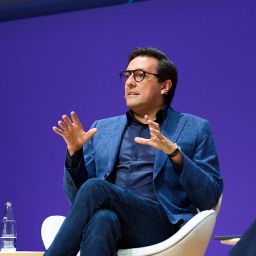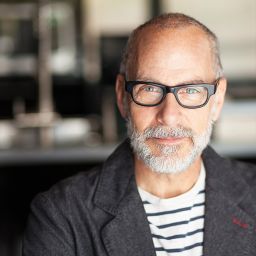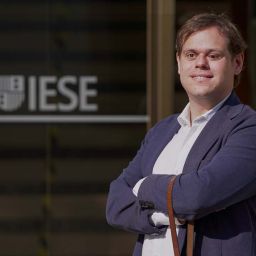Mckinsey says 70% of digital transformations fail, most often due to resistance from employees. And only 16% of employees believe their company’s digital reforms are long-term sustainable.
How do we do it better? How do we more quickly win people to our cause? And how do we create change that’s sustainable?
Well, if anyone should know… Jean-Jacques (JJ) Van Oosten has been called the alchemist. He describes himself as a serial digital transformationist. And he’s lead five large, complex and successful digital and omnichannel transformations at Rewe Group, Tesco, Travis Perkins, LEGO and Kingfisher.
Professor Iñigo Gallo is Associate Professor of Marketing at IESE Business School, one of the world’s best business schools – ranked No.1 in the world for six years running by the Financial Times.
This is Real leadership podcast: Every episode, a business leader shares human stories and hard truths from their career. And an expert turns those stories into lessons we can all learn.
In this episode, Iñigo and JJ discuss:
- The communication skills you need to drive change
- Common factors in all successful business transformations
- Why do people resist change?
- How can you help people resisting change?
Listen to this podcast:
Fore more content like this visit the Real Leadership website.
Podcast transcription:
Adam:
Hello and welcome to This is Real Leadership. Where a proven business leader shares human stories and hard truths from across their career. And an expert turns those words into lessons we can all learn.
In this episode, those lessons are about making change happen. And making it sustainable.
I’m Adam Burns. I’ve been talking and writing about business leadership for over 25 years, and still, every day’s a school day. Which is why, in this podcast, I’m also joined by that expert – a distinguished professor from IESE, one of the world’s best business schools – ranked number 1 in the world for six years running.
They’ll also be talking with our guest. And then, just with me. Offering their expert analysis of the conversation, as I ask: what are the real leadership lessons here? What can we all learn in the next 30 minutes?
Let’s find out. Welcome, Professor Iñigo Gallo.
Iñigo Gallo:
Thank you, Adam. Very happy to be here with you today.
Adam:
It’s great to have you back! Iñigo, you are Associate Professor of Marketing at IESE. Is marketing an underused skillset when it comes to creating and leading successful, sustainable business transformation?
Iñigo Gallo:
One of the things that we often revisit in class is what happens with a lot of startups; they dedicate a lot of effort, a lot of money, a lot of time, and a lot of resources to developing what they think it is that the market needs. And then, when they’re done developing it, they realize that they’ve run out of money, they’ve run out of resources. And, just using that example for this discussion that we’re going to have today with JJ, I’m curious to see if this is the same in his experience; that, many times, we undervalue the necessity of successfully marketing this internally, to overcome that resistance. That, for sure, is going to appear. So yes, of course we’ve got to think about the timeline, and the resources, and the technology, and the outcomes, and how we’re going to finance this. There’s no question – we’re going to think about all those things. But, going back to my startup example, we also need to think about how we’re going to market this, at least internally. And then, of course, how we’re going to communicate this to our customers. But, internally, what can we do to overcome the resistance that, by definition, we’re going to bump into from a lot of people in the organization?
Adam:
Thanks, Iñigo. And I don’t think that’s the last we’re going to hear about communication, or resistance, in this episode.
According to McKinsey, 70% of digital transformations fail, most often due to resistance, well, there you go, from employees. And only 16% of employees believe their company’s digital reforms are long-term sustainable. So, how do we do it better?
Today’s guest should know. Jean-Jacques Van Oosten has been called the alchemist. He describes himself as a serial digital transformationist, having led five large, complex and successful digital and omnichannel transformations at Rewe Group, Tesco, Travis Perkins, LEGO and Kingfisher.
We started by asking JJ what, if anything, those five change projects had in common…
—
JJ Van Oosten:
I think they all had a, sort of, burning platform in common. An absolute need for change because of the change in consumers’ and customers’ behavior – buying far more things on the internet. But also, because of the competition from very large marketplaces, and we all know who they are, putting a lot of pressure on their growth. That’s one element that I could see. The second element that was very clear, which is very important, is that there were very high expectations, and a desire and a will from the chief executive and the chairman of those companies, to actually do and achieve those changes. But they don’t know what the changes are. They don’t know how to do this. And there’s a level of concern, obviously, which many of them have, and also fear, because very few people are capable of enjoying ambiguity. And this ambiguity, this unknown, getting on a boat when you know, more or less, what the destination is, but you don’t quite know how you’re going to get there, requires quite a few skills to bring all of those people together.
Adam:
I find this…this is really interesting to me. And I’ve heard it lots in different places, this notion of not knowing where we’re going. And, being comfortable with ambiguity, and all that sort of thing. How do you prepare someone for being completely unprepared?
Iñigo Gallo:
What happens in class most times is, okay, here’s a big decision that the company is facing. We have reasons both for doing A, and doing B, but we can’t do both at the same time. And there’s probably not one single reason that’s going to win the argument. And so, it’s really about weighing the pros and cons of both options. And, in the end, just saying, “Listen. Just try to get a sense of which of the two options is stronger, or makes more sense, even though it’s not perfect, and even though it doesn’t just have pros and advantages”. And, once you decide, you stick to it, and you push hard for it, because you’re never going to have 100% of the evidence being for something. If that were the case, then it would not be a difficult decision to make. By definition, if it’s a difficult decision, it means that there’s more than one way of going about it. And so, you’ve got to be okay with not having all the data, not having all the arguments, and having that ambiguity that JJ was talking about.
Adam:
Is it important, JJ, to have a bias for action, do you think?
JJ Van Oosten:
I think that helps. But what is crucial and essential is to, very quickly, and in a very simplistic way, articulate the expected outcomes, in terms of the what and the how. And the bias for action comes in there, because you need to do that very quickly. And the skill that I have, really, in myself, mentally, and I have to remain true to it, is to keep that simplicity around the expected outcomes, in terms of the what and how. And to ensure that the complexity of the organization and the environment doesn’t dilute the simplicity that we just aligned ourselves against. When you have that simplicity, then you have a story. And when I have a story, it needs to be tailored to the culture of the company, the history of the company, and it needs to be simple enough that anyone working in a shop, or any of our customers walking to any of our shops, or anyone in a call center, or on a chat online for e-commerce, can understand it within seconds. And that’s hard.
—
So, successful transformation projects have a clearly defined and understood reason for change, desire and will from the Chief Executive, and constant communication around simple outcomes. And you need simplicity, because you’re taking people into a place where they’re expected to be comfortable with not knowing. With ambiguity. The journey itself is confusing, so the destination, at least, should be clear.
The next part of our conversation, though, is about why – even if you have all the things I just listed in place – why people still resist change. And, what you can do about it.
Iñigo Gallo:
My sense is that, in all these projects, as important and as crucial as they are for businesses, the biggest resistance is probably people’s resistance. So, inside the organization, I think there’s a number of reasons why people resist it. Why we all resist it, myself included. So, this is probably a natural human condition that, “Hey, on average, I’m not that excited about change”. Maybe there’s also the sense that traditional things still work – and there are many traditional things that do still work. And so, why do we need to go so fast? Why do we need to change so many things? Maybe there’s also the memory of past failures. Yeah, we tried this technological change, or whatever, many years ago, and it was a complete disaster. And, linked to this, maybe there’s also the sense of, “Hey, let’s see how others do it, and then we’ll jump once it’s been proven”.
JJ Van Oosten:
And, they all think they are serving their customers every day, but most of them don’t know who their customers are. The real question here, and this is where the resistance is, is how do we change our habit of just thinking about products, formats, and processes which have been very successful, as Iñigo was saying, for many years, and add a dimension of customers? Saying, “Okay, who are those customers I have? How many do I need to actually make this budget work? How much does it cost me to acquire new customers? How much does it cost me? And what’s the best way to retain them?” And, adding that new dimension to all of your thinking is pretty difficult to do, to be honest. Because nobody wants to admit that they don’t know who their customers are. Nobody wants to admit that they aren’t serving their customers in the best possible way every day. And that is a big change.
Iñigo Gallo:
I really like the way you put it; that no one likes to admit that he or she doesn’t know their customer. I think this is crucial. And I think, many times, this is something that comes up in class and in many discussions: you are not a fair representation of your market. And so, the first thing we need to do is de-bias ourselves. And the longer you’ve been in the business, the more you need this, right? Because the temptation to tell yourself, “I already know,” gets bigger and bigger the more years you’ve been at it, particularly if you’ve been successful. And so, you tend to think, “All my customers, more or less, behave the way I behave”. This is just a human condition, I guess, that we tend to think that way.
Adam:
So, if you want to do change effectively, do you need to bring in somebody from outside of the company? Is it actually very difficult to do if you’ve been in that company for a long time? Do you need a fresh set of eyes, a fresh voice?
JJ Van Oosten:
You know, if you’ve done the same movements every day, for example, if you’ve been running every day for the last 20 years, but you haven’t been swimming, or if you haven’t done any weightlifting, or whatever, making a change is not enjoyable. It’s painful, or some of it is painful, because it’s a new habit that you have to acquire. And so, there’s definitely something to address there. When you do make those changes, sometimes you bring a coach in to help you learn these new skills, so that you don’t hurt yourself, and so that you learn faster. And, as for the question of outsourcing your transformation, I think that this is, in my personal opinion, a very dangerous thing to do.
—
We resist change because we think everything’s okay, or because we’ve tried it before, or because we’ve been gently institutionalized. And some ways through that are to re-focus – properly, fully, and without preconceived notions – on what your customers do actually want. Bring in a coach to help you add new exercises to your daily fitness routine.
And give your teams the opportunity to not only be a part of that transformation, but to shape it. To create their own future without fear of failure.
JJ believes you achieve this last point through the creation of safe spaces. Crucially, though, they’re safe, but not unchallenging.
—
JJ Van Oosten:
There are two aspects to it. The first one is that, it’s a bit of a cliché, but everyone is welcome. And no one will be criticized for whatever they say, as long as it is within ethical grounds. And those who do not speak will be given the time and the opportunity. I specifically seek out those people, as well, to actually speak. Because some are very introverted, and some are very quiet, but sometimes those people have a lot to contribute, and you have to respect that. That is very important. The cross-functional: so, taking people away from their silos, bringing them together as cross-functional teams working from marketing, supply chain, finance, tech, design product design, etc., and making them work on problems that are very complex to solve. How do you make a new kitchen available and accessible to low-income families, with all the features of using less water, electricity, etc.? You know, these are big, complex problems to resolve. How do you make sure that information is easily digestible on the internet as well? So, those teams are working on that. And by definition, they will challenge some existing practices. It is very important to create an environment where they can do this, and they can actually be rewarded for that. And if they fail, because they take risks, you should actually also celebrate some failures. And that’s okay. The ability to actually recognize that this is a failure, and stop it and not continue – this is a big mindset change. And then, at the very top level, behind closed doors, part of my job is to call out some behavior which is not acceptable from other executives. And that’s because they have to go through their own changes. But, if they think they’re losing power, or whatever, or they come with curve balls, etc., which happens all the time, then, I call it a day, and I say that’s not acceptable. And usually what happens is that, after those difficult discussions at the very top, when some behaviors might not completely be aligned, usually, what happens is that, after a few hours or a few days, we become best friends again. This is why the way you do it is quite important. Because, you might apologize or whatever, but it’s always with the best of intentions. It’s never personal. And I never personally get dragged into the war of words, because then the complexity of the existing organization, and the existing culture, will actually drag down the simplicity of the transformation, and the expected outcomes, and it will slow everything down.
Adam:
I interviewed someone, actually, maybe 10 years ago, who had led a super-huge merger and acquisition in pharmaceuticals. And he said something that’s stuck with me. He said, “The people who will derail your project are not the ones who say no to your face. It’s the ones who say yes to your face but no behind your back”. He called them ‘passive resistors’. How would you deal with them?
Iñigo Gallo:
Yes. I imagine this has to do with something that JJ mentioned at the very beginning. I think, if I remember right, JJ mentioned that the two common things he has experienced in the transformations he has led are that it was needed, and he talked about the changes in the consumer and the changes in competition. But also, I think you mentioned, JJ, that there was a strong, clear, explicit interest from the CEO, or from whoever was in charge. Otherwise, I guess, JJ, it’s a very difficult war to fight, or to put it in a more positive tone, a very difficult conflict to deal with.
JJ Van Oosten:
It’s not possible, to be honest. So, that’s why, I’ve done five, but I always take time. I’ve learned from that, as well. I take time at the beginning, if you have interviews, or whatever it is. But I also interview the company, and the executive team, and the chief executive, and the chairman. Because – do they really understand the consequence of what the expected outcomes that they think they want to have will be? Do they really understand? Because, our job as senior executives is quite simple. It is to give absolute priorities, and not too many of them – a few, clear priorities. And our other job is to give the resources to the teams to actually be successful. But, as resources are not just people and money, it’s also our job, when they encounter blockages, to remove those blockages for them. And they need to be able to do it, not coming with 60 PowerPoint pages, but to do it very fast. All the ways of working based on data and automations need to enable us as a team, top to bottom and bottom to top, to actually have visibility and transparency of what’s going on. And, very clearly, very quickly, when necessary – it could be every day at the beginning, but this is often not the case… On the most important blockages, it might be around, “We cannot have the same SKUs from these vendors that we have been selling for 20 years, etc.”, and that creates conflicts, or it might be around files of product attributes, it might be around pricing strategies and decisions, it might be around the way that you architect things, it might be around some agencies that we might be using in marketing, or whatever. All of this can block some of the teams from making progress. And you need to make sure that you unblock that very quickly.
—
Adam:
So, Iñigo, time for your thoughts. We promised real business lessons you can use. What did you learn? What do you take away from JJ?
Iñigo Gallo:
I think, one thing I really liked is, when he described the responsibility of a top executive in an organization, he mentioned two things, which I think he has probably learned from his projects on transformation, but which I think can be generalized to everything. He mentioned that top executives do two things. They set priorities – just a few, very clear priorities – and they provide resources for the teams. So, those two things are part of the job of a top executive. I also liked when he talked about how, in a project that is this big, transforming an organization, you’ve got to make a very, very strong effort to articulate the expected outcomes. And again, just a few, a handful, not a lot. But, be very clear about what is it that you expect. And then the last one that we spoke a bit about, and which I also liked, is this necessity of creating safe spaces for change. I think this speaks to the other podcasts that we’ve done, about learning from mistakes, with Elena. I think that speaks to this a lot.
Adam:
It is so much about team, isn’t it? It’s so much about people helping each other.
Iñigo Gallo:
Yeah, I think it was constantly there, the theme of getting people on board, understanding people, solving conflict.
Adam:
Thank you to Professor Iñigo Gallo, Associate Professor of Marketing at IESE Business School. And thank you, of course, for listening. Please do subscribe, share and let us know what you think of our podcast. Are companies single-use only, or the rarest of beasts: leopards that can change their spots? Do you think differently to JJ and Iñigo? Please let us know in the comments, or email us. We’d love to hear from you. All details are in the podcast description. But, for now, from me, goodbye.

















